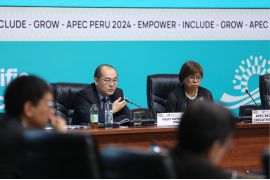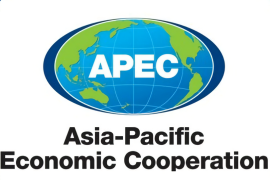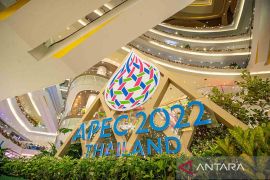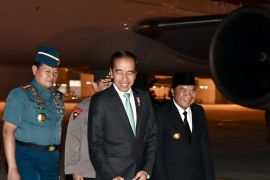"The cheaper the logistic cost is the bigger will be competitiveness in export and import traffic among the regions," said Coordinating Ministry for Economic Affairs` Head of International Cooperation Division Eddy Satriya.Jakarta (Antara News) - Indonesia has an agenda of promoting its connectivity with the Asia-Pacific region during its chairmanship of APEC in 2013 and so has to have comprehensive domestic preparations for it.
World Bank senior economist Sjamsu Rahardja said at an APEC 2013 Focus Group Discussion (FGD) on strengthening Indonesia`s connectivity in the Asia-Pacific region held by the Ministry of Foreign Affairs here on Friday (April 5) that maritime connectivity is a big agenda for Indonesia which it has to achieve first.
As an archipelago country with almost 70 percent of its territory is waters, Indonesia can not avoid building maritime connectivity among its islands. Moreover, mobility and transportation by sea is cheaper than by air.
"Considering that Indonesia is an archipelago country and 70 percent of its territory is made up of waters, we have to be strong first in the domestic connectivity before going global," he said.
According to Rahardja, maritime infrastructure in Indonesia is currently still centered around Java, while in other islands, particularly the eastern region it is still minimum.
This time, the gateway to eastern Indonesia is Makassar, South Sulawesi. In fact, the direct connection, say between Maluku and Java, will be more effective if there are not many transit points for ships to load and unload goods.
Relating to this inefficiency, the World Bank has reported that the connectivity index in Indonesia is recorded at only 2.01 percent which is the lowest among ASEAN member countries, even lower than that of Vietnam at 2.73 percent.
Meanwhile the Indonesia Logistic Performance Index (LPI) is ranked 59th, which is higher than other ASEAN countries like Philippines (52), Thailand (38) and Malaysia (29).
"The high logistic cost in Indonesia, reaching 27 percent of total GDP, will reduce our competitiveness," he said.
Thus, Rahardja said Indonesia should expand development of ports more evenly as the availability of adequate infrastructure will automatically attract investors.
To establish connectivity among the country`s islands, the government cannot merely rely on investors since not all sectors, particularly those outside Java are attractive to investors, he said.
Hence, Rahardja said the government and all stakeholders, including local governments and the private sector, should participate in the development of infrastructure, he said.
"They are related to each other. The development of ports will enable regions to establish connectivity and then open a wider network with one another. Strong domestic connectivity will enable us to enter the ASEAN and APEC connectivity easily," he said.
On the other hand, Coordinating Ministry for Economic Affairs` Head of International Cooperation Division at the Secretariat of the Committee for Acceleration and Expansion of Indonesia Economic Development (KP3I) Eddy Satriya said Indonesia will follow the Master Plan for the Acceleration and Expansion of Indonesian Economic Growth (MP3I) in developing its infrastructure.
He said infrastructure development in Indonesia is aimed at supporting the six economic corridors set in the MP3I to improve supply chain of goods, services and information, reduce logistic cost, reduce inefficiency, improve access to all regions and synergy among development centers.
"We aim to make a breakthrough to create high, inclusive, equal, and sustainable economic growth," he said.
Although a strategic plan has been made Satriya said there are still some major problems hindering the implementation of the MP31 programs, one of which is unequal development in Indonesian regions.
According to the Central Statistic Agency (BPS), the development of infrastructure in Indonesia has been centered on Java and Sumatra islands.
Therefore, the KP3I has planned to establish a connected network of infrastructure, information and broadband (ICT) to establish maritime infrastructure to improve national and international connectivity.
"To make this plan to work, we will need huge investment and commitment," said Satriya.
Therefore, KP3I has decided that the private sector should be involved in the infrastructure development program through the establishment of a special financial institution for infrastructure development.
In line with the KP3I program, the National Development Planning Agency (Bappenas) has given indicators of the total investment needed for each of the corridors in the MP3I namely Sumatra, Java, Kalimantan, Sulawesi, Bali-Nusa Tenggara, and Papua-Maluku reaching Rp4,012 trillion or around US 422,31 billion dollar in 2014 which is expected to come from the private sector (51 percent), the government (10 percent), the State-Owned Companies (18 percent), and mix-sources (21 percent).
The Indonesian Government, Satriya said has also sought to optimize the use of the ASEAN Infrastructure Fund (AIF) as the new source of funds for the infrastructure development.
Regarding the "Pendulum Nusantara Project" (Pendulum of the Archipelago) as one of the efforts to improve sea traffic in Indonesia, World Bank Senior Economist Sjamsu Rahardja said it is already on the right track, but it needs to be developed in order to attract more investment in the shipping industry.
The Pendulum Nusantara Project is a sea freight transport program aimed at cutting logistic cost by improving movement of goods along the country`s vast waterways. Under the program, the government will use six seaports, Belawan, Batam, Tanjung Priok, Tanjung Perak, Makassar and Sorong, as the main gateways. The government started the project in 2012.
"In order to establish a maritime connectivity, we need to complete all facilities and infrastructures. To build a harbor means we have to also establish broadband mechanism to support a major sea traffic system, for example," said Rahardja.
The Pendulum Nusantara project which is also known as the East-West Pendulum is predicted to cut domestic logistic cost by a third or a half. As an illustration the cost for shipping a twenty-foot equivalent unit cargo container from Jakarta to Padang, West Sumatera (1,000 km), is US 500 dollar, while from Jakarta to Hamburg (11,000 km) is US 2,700 dollar, he explained.
"If we compare the distances, we can say it is cheaper to ship a cargo from Jakarta to Hamburg than to Padang," he said.
Regarding the APEC connectivity Eddy Satriya said the Pendulum Nusantara Project will support maritime connectivity development in Indonesia while the infrastructure development is now still in progress.
"Needless to say that ideally, we must provide a port for each potential coastal region, but it is not cheap to build a port for every region at the same time," he said.
"The cheaper the logistic cost is the bigger will be competitiveness in export and import traffic among the regions," he added.
In the first phase of the Pendulum Nusantara Project, the Government has allocated RP1.5 trillion (US 159 million dollar) to handle ships of 3,000 TEUs.
The government would also improve soft infrastructure like the soon to-be-implemented "Inaportnet", an online system to ease processing of exports and imports.
Indonesia will also promote connectivity in the Asia-Pacific region as part of its APEC chairmanship this year through three pillars, physical, institutional and people-to-people connectivity, an envoy said.
Connectivity framework
To promote connectivity in the Asia-Pacific region as part of its APEC chairmanship program this year, Indonesia has established three pillars, physical connectivity, institutional connectivity and people-to-people connectivity, an envoy said.
Alternate Senior Official of Indonesia for APEC 2013 M Wahid Supriyadi said at a Focus Group Discussion (FGD) on the strengthening of Indonesia`s connectivity and that of the Asia-Pacific region held by Ministry of Foreign Affairs in Jakarta on Friday (April 5) that the three pillars were aimed at supporting national interests during Indonesia`s chairmanship of APEC under the Framework on Connectivity.
The Ministry of Foreign Affairs held this FGD to collect suggestions and views from national stakeholders with regard to the APEC Framework on Connectivity as well as to supporting national connectivity as contained in the Master Plan for the Acceleration and Expansion of Indonesian Economic Growth (MP3I) whose result will be brought to the APEC Summit in Bali in November 2013.
"The World Bank has issued a report that our connectivity index which is at 2.01 percent is the lowest among ASEAN countries, even lower than that of Vietnam at 2.73 percent," he added.
Therefore, Supriyadi added Indonesia needs to take more action plans to strengthen its domestic connectivity with the Southeast Asias and Asia-Pacific regions.
He said the physical connectivity is designed to improve the quality and connectivity of trade, travel, energy, and telecommunication infrastructures where Indonesia has specifically proposed a long-term principal concept underlying the infrastructure development and investment in Asia and the Pacific.
The institutional connectivity is focused on issues of trade and investment as well as efforts to increase coherence and interoperability between institutions and mechanism in the APEC economies.
Meanwhile, the people-to-people connectivity is aimed at deepening interaction, network and inter-community relations as well as professional mobility in the APEC region, he said. (*)
(T.A060/H-YH)
Reporter: A Fitriyanti
Editor: Fardah Assegaf
Copyright © ANTARA 2013












